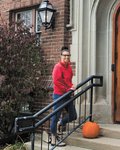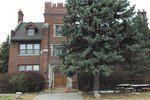

The historic brick mansion on Como Ave., one block east of the Minnesota State Fairgrounds, has stood guard on its corner for more than 100 years. Designed by Minnesota state architect Clarence Johnston Sr. in 1913, it originally served unwed mothers and their babies as the Booth Memorial Hospital.
In the 1970s, it became a residential facility for girls with emotional and behavioral challenges. Services for boys were added in 1984, including a residential treatment program and a separate 10-bed emergency shelter.
Always owned and operated by the Salvation Army, Booth Memorial Hospital has continued its mission of serving young people, almost without interruption, up until the present day. It had to close its doors for two years in 2010, due to lack of funding.
It re-opened in 2012 as the Booth Brown House (BBH), thanks to a $400,000 gift from local philanthropist Earle Brown. BBH continues to serve youth dealing with the critical issues of the time.
Topping the list of critical issues currently is youth homelessness.
According the most recent Wilder Foundation data, there are nearly 500 homeless youth (ages 18-21) on the streets of Minneapolis and St. Paul every night.
BBH program director of the Emergency Shelter and Foyer Housing Program Erin Foss said, “Typically, many of those youth would be couch surfing with friends or extended family, but with COVID-19, that’s not happening right now.”
BBH has beds for 16 youth (ages 18-21) in their emergency shelter. Because all of the rooms are shared, that number is being capped at 13 to keep COVID-19 exposure down.
Another factor limiting availability of beds, according to Foss, is that youth are staying longer at BBH because of COVID-19 and the lack of jobs.
Typically, Ramsey County residents can stay up to 90 days in the emergency shelter, and residents of other counties can stay up to 30 days.
Staff provides the following services on-site to help empower youth: social services, connecting to education, job search help, budgeting, tax assistance, tutoring, case management, cultural enrichment, recreation and fun, spiritual ministries, and aftercare for former program participants.
Every one of these things would be difficult to manage, if one didn’t have a home.
The second housing option for youth at BBH is called the Foyer Housing Program. This program offers stable, affordable housing to young people with rents well below the market rate. There are supportive services available on-site, and resources to help in the eventual transition to independent living. Each tenant signs a lease, and rents a furnished efficiency apartment at BBH for no more than 30% of their income.
No State Fair parking means major loss of revenue
COVID has created a new normal at BBH, just like it has everywhere.
The major BBH fundraiser comes from their State Fair parking revenue. Foss said, “Who would have thought that a parking lot would be such a huge revenue generator? We can usually count on making about $45,000, but obviously that didn’t happen this year.”
Adopt a resident
What are some ways to connect with the ongoing work of BBH during the pandemic? While volunteers aren’t able to enter the building right now, community members can still get involved.
Foss explained that holidays can be especially hard for young people at BBH. She said, “We try to make sure that the youth staying in our emergency shelter have a grab bag of small things like warm socks, ear buds, or a gift card they can spend nearby.
“We take a different approach to the Foyer Housing Program, because these young people might be with us for years. Each resident comes up with a holiday wish list, and the wishes tend to be modest. We ask community members to sponsor or adopt residents for the holidays. We keep identities private, but we can provide basic demographic information such as age and gender.”
Foss said, “Sometimes I wonder what would happen if there weren’t places like the Booth Brown House. If we can find young people who are struggling and get them into a program like ours, which is small and supportive – the whole community benefits in the long run. There are kids experiencing homelessness everywhere. Their goals and dreams are the same as any other kids. They’re just kids.”
The Booth Brown House is located at 1471 Como Ave. The Salvation Army is always looking for new members to join their advisory committee. Call 651.646.2601 to make a holiday donation, adopt a resident for the holidays, or learn more about the monthly advisory committee meetings.
Comments
No comments on this item Please log in to comment by clicking here